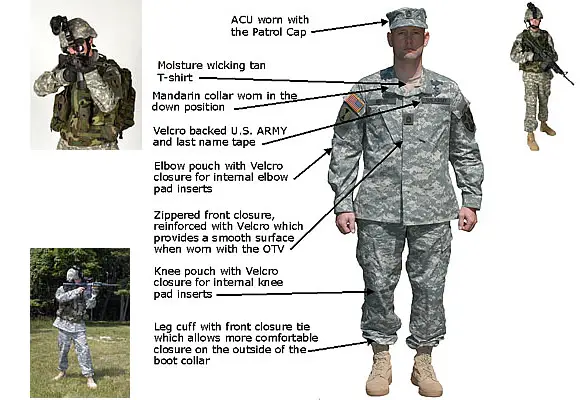
Posted: 06/01/2004
June 16, 2004: After years of complaints from the troops, and 18 months ofeffort, the U.S. Army has a new combat uniform. There will be only one colorscheme (light green, tan and gray) for this uniform (instead of the current two,one for deserts and the other for temperate climate zones). The new uniform alsoincludes tan combat boots (that cannot be shined, you just brush the crud offthem). There is no black in the uniform, because it was pointed out that blackis not a color you encounter much in nature. The new uniform costs $88,replacing the $56 BDU, which was introduced in 1981.
Officially called the ACU (Army Combat Uniform), the major changes are allresponses to numerous requests from the troops. These changes include;
Mandarin (high) collar that can be worn up or down. When worn up, this keep crudfrom getting down inside the shirt, and eliminates chafing from the protectivevest.
Rank insignia can be attached above the right chest pocket with Velcro.
Velcro is also used for attaching the unit patch, skill tabs and recognitiondevices. This spares troops the hassle of sewing on, and later removing,patches. The Velcro also allows all the patches and such to be removed beforethe uniforms are sent to the laundry.
Zippered front on the shirt, which is easier to close than buttons.
Elbow pouch for internal elbow and knee pad inserts. The introduction of kneeand elbow pads in the 1990s saved thousands of infantry troops from painful, andsometimes permanent, injuries. Infantry spend a lot of time getting down onelbows and knees, especially in combat. The inserts are cheaper and easier touse than the more traditional elbow and knee protectors similar to those you seein sporting goods stores.
Elastic leg cuff, a useful item for keeping the crud out when you are in thefield.
Tilted chest pockets with Velcro closure. Makes the pockets easier to use whenwearing your webbing gear.
Three-slot pen pocket on bottom of sleeve. Again, convenience.
Velcro sleeve cuff closure. Keeping the crud at bay once more.
Shoulder pockets with Velcro. When troops are wearing their webbing gear andpacks, shoulder pockets are the only ones you can get at easily.
Forward tilted cargo pockets. Again, convenience.
Integrated blouse bellows for increased upper body mobility. Again, convenience.
Integrated Friend or Foe Identification Square on both left and right shoulderpocket flap. This is a current method for making it easier to avoid friendlyfire incidents. The Velcro makes it easy to take these patches off at night,when they tend to make the troops more visible.
Bellowed calf storage pocket on left and right leg. Again, convenience.
Moisture-wicking desert tan t-shirt. Troops have been buying these with theirown money for years.
Patrol Cap with double thick bill and internal pocket. Complaints about thefragile bill, and troops sewing pockets into the cap led to this.
Improved hot-weather desert boot or temperate-weather desert boot. Manycomplaints and recent experience in Afghanistan and Iraq.
During development, three different versions of the ACU were created and over10,000 uniforms were manufactured and tested in Iraq and at Army trainingcenters. Hundreds of changes were made in response to soldier comments. Whilethe new uniform looks ugly to many civilians, it�s very comfortable. This ispartly do to the bagginess. But in combat, the troops prefer loose andcomfortable to tight and fashionable. Troops will begin getting the new uniformin 2005, and all will have it by 2007.